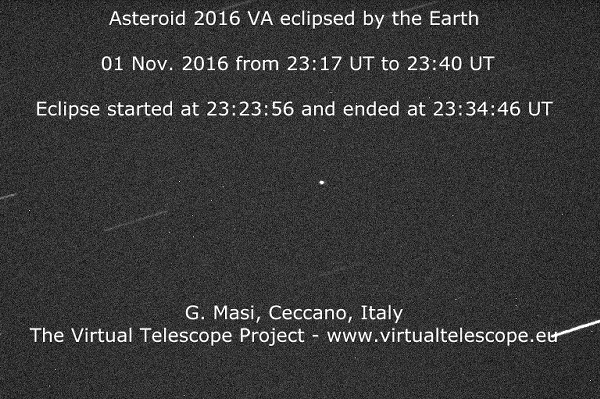Astronomers Just Watched an Asteroid Skim Through Earth’s Shadow
The short video was tricky to shoot
/https://tf-cmsv2-smithsonianmag-media.s3.amazonaws.com/filer/31/79/3179fac4-4d80-448e-880e-60963a4cf4c2/screen_shot_2016-11-02_at_41238_pm.png)
On Tuesday evening, a newly spotted asteroid flew within a stone’s throw of our planet. While it was far enough away to miss our atmosphere, astronomers spotted the space rock as it flew through Earth’s shadow.
Asteroids whizz by all the time, and it’s worth noting up front that in many ways this was no different. At around 40 feet across, 2016 VA (as the astronomical community dubbed it) is similar in size to the meteorite that exploded above the Russian city of Chelyabinsk back in 2013, David Dickinson writes for Universe Today. While this one might have also made a bit of a boom had it come closer to Earth, it wouldn’t have sent humanity the way of the dinosaurs.
That doesn’t mean that 2016 VA wasn’t exciting in it’s own way. While it didn’t enter our atmosphere, it did pass within a hair’s width of our planet, cosmically speaking: about 47,000 miles away, or within 20 percent of the distance to the moon, Maddie Stone reports for Gizmodo. The news of its arrival sent astronomers scrambling to catch a glimpse of the asteroid before the speedy rock flew by.
As 2016 VA sped towards the Earth, astronomers at the Virtual Telescope Project caught it on camera. Using a robotic instrument dubbed “Elena,” the researchers recorded the asteroid as it flew towards our planet and passed into our shadow—a tough shot considering how how fast the rock was flying, Stone reports.

As Virtual Telescope Project researcher Gianluca Masi explains in a blog post:
The robotic mount tracked the extremely fast (570″/minute) apparent motion of the asteroid, so stars are trailing. The asteroid is perfectly tracked: it is the sharp dot in the center, marked with two white segments....to our knowledge, this is the first video ever of a complete eclipse of an asteroid.
It took about 11 minutes for Earth to eclipse the speedy asteroid. By speeding it up, however, this video highlights the drama of the moment, which likely won’t happen again this century, Stone writes.
This isn’t the only small asteroid to pop up on astronomers’ radars recently. In the last few weeks, a new “early warning system” being developed by NASA spotted a much larger asteroid than 2016 VA during a test. At up to 82 feet across, this might have made a bigger bang, but luckily it happened to fly by at about 310,000 miles away, Joe Palca reports for NPR.